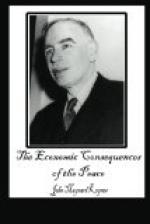On November 5, 1918, the President transmitted to Germany the reply he had received from the Governments associated with him, and added that Marshal Foch had been authorized to communicate the terms of an armistice to properly accredited representatives. In this reply the Allied Governments, “subject to the qualifications which follow, declare their willingness to make peace with the Government of Germany on the terms of peace laid down in the President’s Address to Congress of January 8, 1918, and the principles of settlement enunciated in his subsequent Addresses.” The qualifications in question were two in number. The first related to the Freedom of the Seas, as to which they “reserved to themselves complete freedom.” The second related to Reparation and ran as follows:—“Further, in the conditions of peace laid down in his Address to Congress on the 8th January, 1918 the President declared that invaded territories must be restored as well as evacuated and made free. The Allied Governments feel that no doubt ought to be allowed to exist as to what this provision implies. By it they understand that compensation will be made by Germany for all damage done to the civilian population of the Allies and to their property by the aggression of Germany by land, by sea, and from the air."[7]
The nature of the Contract between Germany and the Allies resulting from this exchange of documents is plain and unequivocal. The terms of the peace are to be in accordance with the Addresses of the President, and the purpose of the Peace Conference is “to discuss the details of their application.” The circumstances of the Contract were of an unusually solemn and binding character; for one of the conditions of it was that Germany should agree to Armistice Terms which were to be such as would leave her helpless. Germany having rendered herself helpless in reliance on the Contract, the honor of the Allies was peculiarly involved in fulfilling their part and, if there were ambiguities, in not using their position to take advantage of them.




